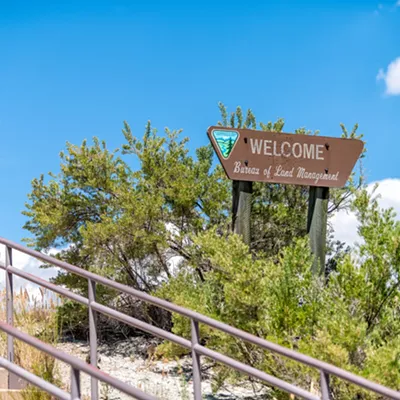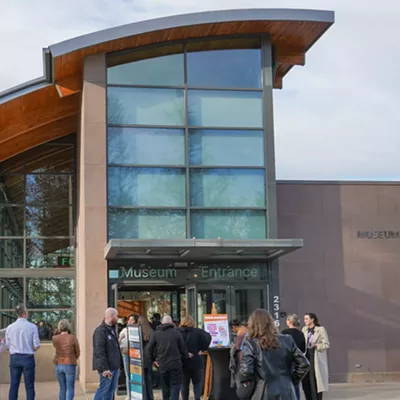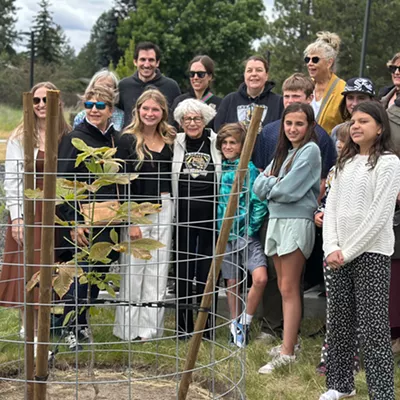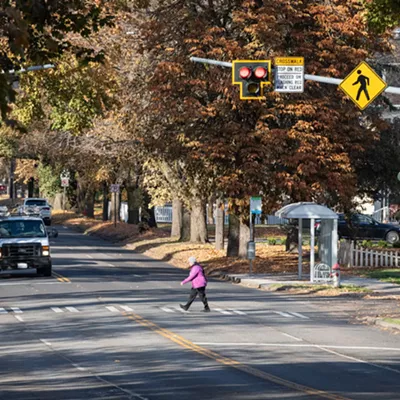As I enter Arbor Crest's production facility in the northwest corner of the Valley, General Manager and Viticulturist Jim van Loben Sels greets me at the gate. Right behind me is a pickup truck pulling a flatbed trailer with precious cargo. Mike and Winnie Alberg are delivering three tons of merlot grapes just harvested that morning from their Stillwater Creek Vineyard.
The grape harvest is a labor-intensive time of year for wineries. All hands are on deck -- five, in Arbor Crest's case. To bring in and process the harvest at Arbor Crest's production facility, winemaker Kristina Mielke-van Loben Sels spends 10-12 hours a day, seven days a week. She's grateful to have Martin Jennings as assistant winemaker to help with her responsibilities during the six to eight weeks of harvest time.
As we watch the bins being unloaded, Kristina explains why Stillwater Creek's grapes are so precious. "The grapes are grown on a ridge north of the Waluke Slope in the Columbia Valley on basalt rock," she says. "They have great growing conditions."
Kristina says they get a diversity of grapes from seven or eight vineyards in the Columbia Valley. Jim tells the grape growers how he wants the grapes grown and checks on the fruit often -- during the growing season, weekly.
"We pick according to how the grapes taste," Kristina reveals. "That flavor is so important."
Kristina invites me to taste-test these sun-warmed grapes. Their flavor is indeed rich and sweet, mirroring their deep indigo/purple color. Kristina describes the flavor as similar to brown sugar.
But these grapes won't see the sun much longer. As soon as they're unloaded, they're dropped into a huge stainless steel hopper with a large augur at the bottom, which moves them to the crusher/de-stemmer. Standing above the churning mass of grapes, Kristina uses a long, wooden pole to move the fruit along and remove any leaves.
"A lot of people are going to machine harvesting, but I like hand-picked grapes," Kristina says. "That way I can weed out anything I don't like. With machine harvesting, the berries can break and fermentation could start before they're processed."
Plucked from their stems, the grapes are pumped into 1,000-gallon stainless steel containers in Arbor Crest's tank room, where the fermentation process begins. The pungent scent that permeates the tank room is unmistakable, as the grape sugar is converted into ethyl alcohol and CO2 by the yeast enzymes.
"It's so important for red wine to ferment at the proper temperature," Kristina says. "You have to have the right heat for the proper extraction. If it's too hot, it will kill the yeast."
As she punches down the dark red grape skins in an open tank, using what looks like a stainless steel, triangular-shaped hoe, Kristina says the grapes stay in the fermenting tanks for "quite awhile" -- until the fermentation stops naturally or she stops it deliberately, according to its sweetness.
"I taste it to see how dry it is and if the skins are adding anything," she explains. "We run an analysis of the sugar level (brix) and the temperature daily. We always do a full analysis to check the acidity, ph and nutrient level to see if it needs anything added. With a hot year like we've had this summer, the acid drops out as the grapes ripen, so we may have to add tartaric acid."
Winemaking is a blend of intuition, taste and science, Kristina tells me. She draws on her experience at Arbor Crest and Ferrari-Carano Vineyards in Healdsburg, California, as well as her knowledge of chemistry and fermentation science from the University of California at Davis.
Kristina is the second generation of the Mielke family to oversee Arbor Crest. Her parents, Dr. C. Harold Mielke Jr. and Marcia Mielke, founded Arbor Crest Wine Cellars in 1982 on the grounds of the Mielke family's cherry orchard. Actually it goes back a few generations. When she was a girl, Marcia Mielke crushed Zinfandel grapes in a barrel for her grandfather's homemade wine.
Jim van Loben Sels also has winemaking in his blood. As a boy growing up in California, he worked alongside his uncle in his vineyards. After studying agricultural economics at U.C. Davis, he went on to supervise irrigation management for vineyards throughout northern California.
"We're the fifth-largest family-run winery in the state of Washington," Jim says proudly. "And we're 15th to 17th in production in the state."
Arbor Crest's wines have garnered many awards and accolades. Both the prestigious Wine Spectator and Wine & amp; Spirits magazines rated Arbor Crest's 2000 cabernet sauvignon with a high 90 points out of 100. It also received a gold medal at this year's Dallas Morning News wine competition. This full-bodied wine blends grapes from five Columbia Valley vineyards. Barrel-aged for 20 months, it features chocolate, red currant and plum flavors with a hint of spices and herbs. Winepress Northwest magazine named Arbor Crest the winery of the year in 2001, calling it "an exciting winery to watch." So what makes Arbor Crest's wine so special?
"We age our wines in French oak barrels, tasting it during that process to see if it's too acidic," Kristina says. "We always keep our eye on our wines with tender, loving care. I have a passion for the art and science of winemaking."
"We don't cut corners," Jim adds. "We do all that we can to make our wine the best possible product. We allow the grape that was harvested to come through."
It's a long process from grape to bottle. The grapes that I've seen processed at Arbor Crest today won't be bottled until 2005. Once the fermentation process is complete, the merlot is aged in oak barrels for 18 months and bottle-aged another six months.
The winemaking tradition lives on at Arbor Crest. Jim and Kristina's eight-month-old son Jack has been helping with this year's crush. As a load of grapes came in last week, he kept an eye on the clusters to make sure they all looked good.
"Arbor Crest has been at this for 20-plus years," Jim says. "Now we're taking it to the next level."
Publication date: 10/02/03
















